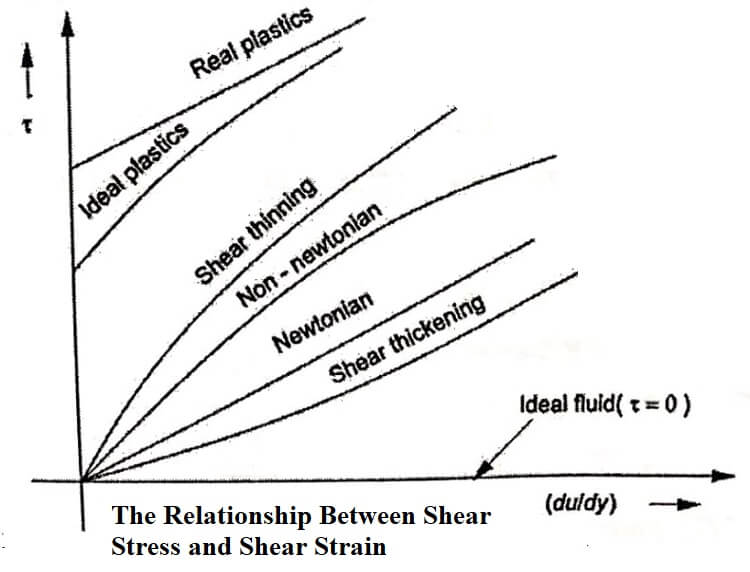
Fluid may be defined as a substance which is capable of flowing. It has no definite shape of its own but it confirms the shape of the containing vessel. A small amount of shear force exerted on a fluid will cause it to undergo a deformation. It continues as long as the force is to be applied.
Generally, matter exists in three states. They are as follows.
- Solid
- Liquid and
- Gas
Although differences in many aspects, liquids and gases have a common characteristic in which they differ from solids. The liquid and gas together are called by the common term ‘fluids’.
A fluid is a substance which deforms continuously under the action of shear stress. In addition, it has the following properties:
- It is unable to retain any unsupported shape.
- It flows under its own weight and takes the shape of any solid body with which it contained.
- A fluid in equilibrium cannot sustain any shear.
- It cannot regain its original shape on the removal of shear force.
- Shear stresses occur in fluids only when they are in motion.
- The rate of strain is directly proportional to the applied stress.
Fluid mechanics is a physical science related to the behaviour of fluid at rest and in continuous motion: It consists of two approaches such as empirical hydraulics and classical hydrodynamics. The empirical hydraulics deals the motion of water but the classical hydrodynamics deals the flow analysis based on concept of ideal fluid.
Distinction Between Solid and Fluid
In nature, all matter exists in any one of three forms of states such as solid, liquid or gas, or in a mixture of these forms. The liquid form and gaseous form are usually combined and given a common name of fluid because of the common characteristics exhibited by liquids and gases.
A solid is generally concerned as a substance that has its own shape and undergoes an infinitesimal change in volume under pure compressive load. It offers the resistance to change in shape without a change in volume under the application of tangential forces. This force may cause some displacement of one layer over other in the direction of the applied force but the material will not continue to deform indefinitely. When this force is removed, the deformation produced will disappear and a critical limit has not been exceeded.
The spacing and latitude of motion of molecules are very small in solids, large in a liquid and extremely large in gas. Accordingly, the intermolecular bonds are very strong in solids, weak in liquids and very weak in gases. It is due to that the solid is very compact and rigid. The common materials classified as solids are bricks, steel, diamond, wood, rubber, plastics etc.
The fluids do not have their own shape and they do not offer any resistance to change in shape when a deforming tangential force is applied. They continuously deform under the action of such forces, however less the force may be.
The continuous deformation under the action of tangential force causes liquids and gases to flow rather than to remain as solid. The common examples of fluids are water, kerosene, milk, gasoline, air, steam etc.
Classification of Fluids
Fluids are classified as follows:
- Ideal fluids and Real or Practical fluids.
- Newtonian fluids and Non-Newtonian fluids.
Ideal Fluids : Ideal fluids have the following properties.
- It is incompressible.
- It has zero viscosity.
- The shear force is zero when the fluid is in motion i.e. No resistance is offered to the motion of any fluid particles.
Real or practical Fluids
- t is compressible.
- They are viscous in nature.
- Some resistance is always offered by the fluid when it is in motion.
- Shear stress always exists in such fluids.
Newtonian Fluids
In Newtonian fluids, a linear relationship exists between magnitudes of shear stress τ and the resulting rate of deformation (du/dy). i.e. the constant of proportionality µ does not change with the rate of deformation.
![]()
Example : Water, Kerosene.
The viscosity at any given temperature and pressure is constant for a Newtonian fluid and is independent of the rate of deformation.
Non-Newtonian Fluids
In Non-Newtonian fluids, there is a non-linear relation between the magnitude of the applied shear stress and the rate of deformation. The viscosity will vary with the variation in the rate of deformation. They do not obey Newton’s law of viscosity.
Non-Newtonian fluids can be further classified into five groups. They are simple Non-Newtonian, ideal plastic, shear thinning, shear thickening and real plastic fluids. Simple non-Newtonian has already explained. In plastics, there is no flow up to a certain value of shear stress. After this limit, it has a constant viscosity at any given temperature.
In shear thinning materials, the viscosity will increase with the rate of deformation (du/dy). In shear thickening materials, the viscosity will decrease with the rate of deformation (du/dy). Example: Non-Newtonian fluids are paint, toothpaste, and printer’s ink.
- See More : Vertical axis wind turbine
- See More : Horizontal axis wind turbine
- See More : Component of tidal power plants





